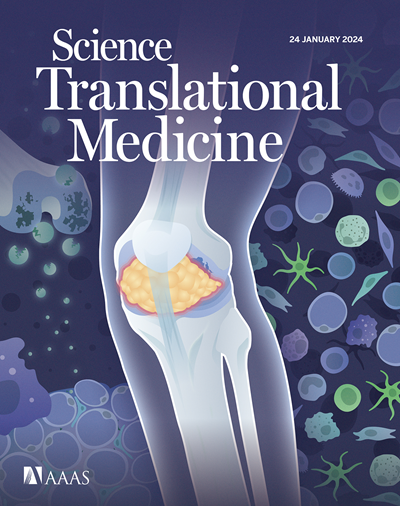纤维蛋白靶向治疗胃癌的研究进展
IF 15.8
1区 医学
Q1 CELL BIOLOGY
引用次数: 0
摘要
晚期胃癌(GCa)患者的治疗选择有限,需要替代治疗方法来改善其临床结果。由于纤维蛋白在胃肿瘤中含量丰富,而在健康组织中含量不高,我们假设纤维蛋白可以作为一种高能β -释放细胞毒性放射性药物的高浓度储存库传递到肿瘤细胞中。我们发现纤维蛋白存在于64 - 75%的原发性胃肿瘤和50 - 100%的转移性胃腺癌核心。7例胃或胃食管结癌患者的首次人体64 Cu-FBP8纤维蛋白靶向正电子发射断层扫描(PET)成像显示,所有靶病变的探针摄取都很高,原发肿瘤(n = 7)的肿瘤与背景(肌肉)的摄取比为9.9±6.6,转移肿瘤(n = 45)的摄取比为11.2±6.6。使用两种人类GCa小鼠模型,一种纤维蛋白高(SNU-16)和一种纤维蛋白低(NCI-N87),我们发现PET成像与相关的纤维蛋白特异性肽CM500相关,该肽被铜-64 (64 Cu-CM500)标记,特异性结合并精确量化了两种模型中的肿瘤纤维蛋白。然后,我们用钇-90标记纤维蛋白特异性肽CM600,并表明90 Y-CM600有效地降低了这些小鼠模型中的肿瘤生长。携带高纤维蛋白SNU-16肿瘤的小鼠对单一高剂量或分次低剂量90 Y-CM600均有肿瘤生长抑制和延长生存的反应,而携带低纤维蛋白NCI-N87肿瘤的小鼠对分次低剂量90 Y-CM600的反应则有延长生存的反应。这些结果为纤维蛋白靶向治疗奠定了基础,可能扩大晚期GCa患者的选择。本文章由计算机程序翻译,如有差异,请以英文原文为准。
Development of a fibrin-targeted theranostic for gastric cancer
Patients with advanced gastric cancer (GCa) have limited treatment options, and alternative treatment approaches are necessary to improve their clinical outcomes. Because fibrin is abundant in gastric tumors but not in healthy tissues, we hypothesized that fibrin could be used as a high-concentration depot for a high-energy beta-emitting cytotoxic radiopharmaceutical delivered to tumor cells. We showed that fibrin is present in 64 to 75% of primary gastric tumors and 50 to 100% of metastatic gastric adenocarcinoma cores. First-in-human 64Cu-FBP8 fibrin–targeted positron emission tomography (PET) imaging in seven patients with gastric or gastroesophageal junction cancer showed high probe uptake in all target lesions with tumor-to-background (muscle) uptake ratios of 9.9 ± 6.6 in primary (n = 7) and 11.2 ± 6.6 in metastatic (n = 45) tumors. Using two mouse models of human GCa, one fibrin-high (SNU-16) and one fibrin-low (NCI-N87), we showed that PET imaging with a related fibrin-specific peptide, CM500, labeled with copper-64 (64Cu-CM500) specifically bound to and precisely quantified tumor fibrin in both models. We then labeled the fibrin-specific peptide CM600 with yttrium-90 and showed that 90Y-CM600 effectively decreased tumor growth in these mouse models. Mice carrying fibrin-high SNU-16 tumors experienced tumor growth inhibition and prolonged survival in response to either a single high dosage or fractionated lower dosage of 90Y-CM600, whereas mice carrying fibrin-low NCI-N87 tumors experienced prolonged survival in response to a fractionated lower dosage of 90Y-CM600. These results lay the foundation for a fibrin-targeted theranostic that may expand options for patients with advanced GCa.
求助全文
通过发布文献求助,成功后即可免费获取论文全文。
去求助
来源期刊

Science Translational Medicine
CELL BIOLOGY-MEDICINE, RESEARCH & EXPERIMENTAL
CiteScore
26.70
自引率
1.20%
发文量
309
审稿时长
1.7 months
期刊介绍:
Science Translational Medicine is an online journal that focuses on publishing research at the intersection of science, engineering, and medicine. The goal of the journal is to promote human health by providing a platform for researchers from various disciplines to communicate their latest advancements in biomedical, translational, and clinical research.
The journal aims to address the slow translation of scientific knowledge into effective treatments and health measures. It publishes articles that fill the knowledge gaps between preclinical research and medical applications, with a focus on accelerating the translation of knowledge into new ways of preventing, diagnosing, and treating human diseases.
The scope of Science Translational Medicine includes various areas such as cardiovascular disease, immunology/vaccines, metabolism/diabetes/obesity, neuroscience/neurology/psychiatry, cancer, infectious diseases, policy, behavior, bioengineering, chemical genomics/drug discovery, imaging, applied physical sciences, medical nanotechnology, drug delivery, biomarkers, gene therapy/regenerative medicine, toxicology and pharmacokinetics, data mining, cell culture, animal and human studies, medical informatics, and other interdisciplinary approaches to medicine.
The target audience of the journal includes researchers and management in academia, government, and the biotechnology and pharmaceutical industries. It is also relevant to physician scientists, regulators, policy makers, investors, business developers, and funding agencies.
 求助内容:
求助内容: 应助结果提醒方式:
应助结果提醒方式:


